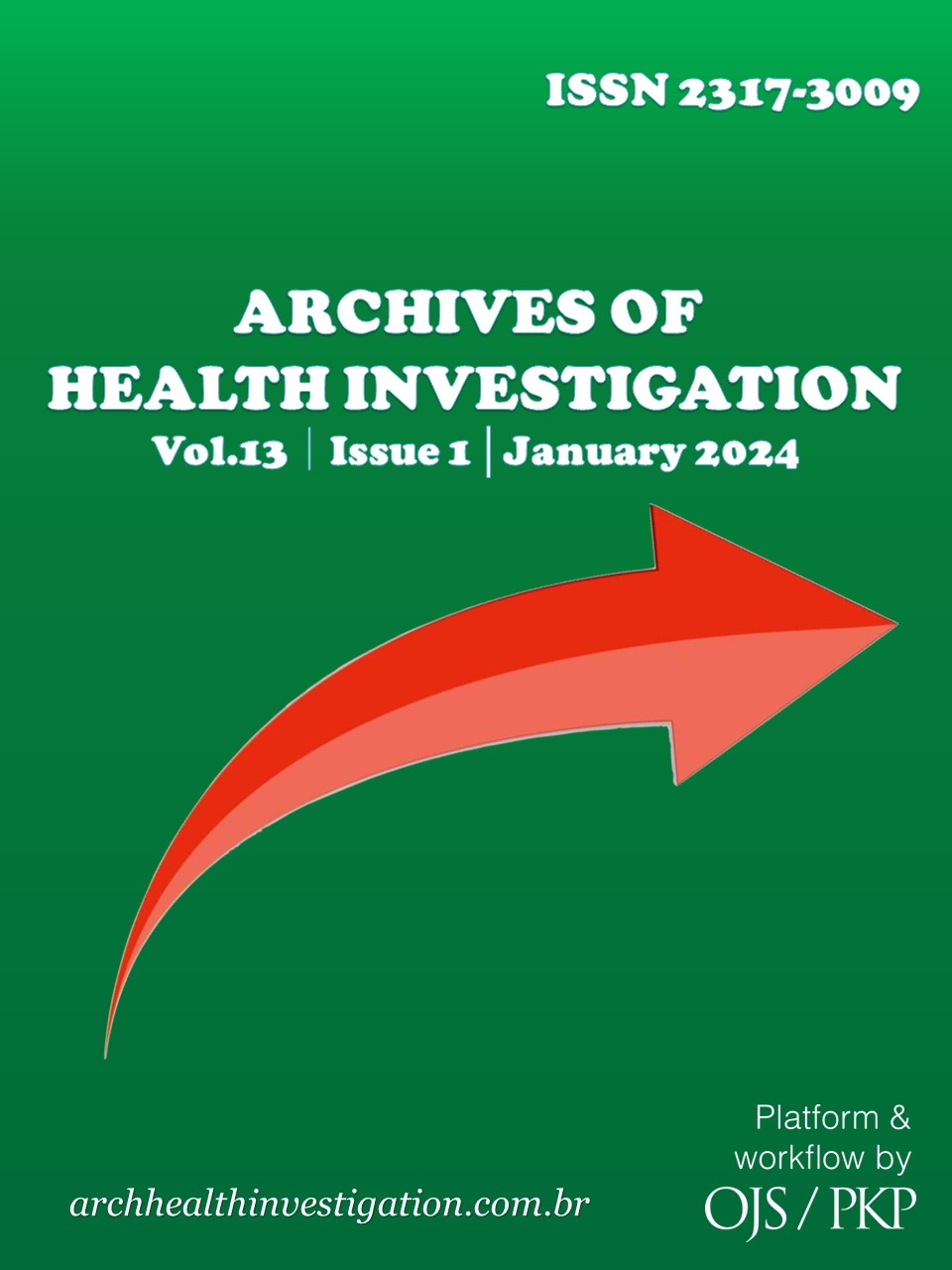Epidemiology of Supracondylar Fractures of the Humerus in Children
DOI:
https://doi.org/10.21270/archi.v13i1.6324Palavras-chave:
Humeral Fractures, Elbow Joint, ChildResumo
Background: Supracondylar fracture of the humerus are the second most common fracture in pediatric patients. There are few studies concerning their epidemiology in Brazil. This study aims to assess the clinical and epidemiological characteristics of supracondylar fractures of the humerus in children managed at a tertiary-level hospital within the Brazilian Unified Health System (translation for SUS - Sistema Público de Saúde). Methods: This retrospective study included patients younger than 13 years diagnosed with supracondylar fracture of the humerus assisted at an urgent and emergency referral unit of the Unified Health System from June 2022 to July 2023. The statistical analysis used R software version 4.0.4 with a significance level set at 0.05 using descriptive and inferential statistics. Results: 197 children with mean age of 5.4 years (2.4) were diagnosed with a supracondylar fracture of the humerus. The highest temporal incidence occurred in December, being 56.9% male patients, 81.3% identified as African American, and 51.8% had a fracture on the left side. The most prevalent cause for the fracture was a fall from standing height on the outstretched hand. At least 95% of the patients had extension fractures, and the distribution by Gartland classification was: I, 36.7%; II, 26.2%; III, 30.9%; and IV, 6.3%. Three patients had a neurological injury. All patients with III and IV fractures, as well as those with flexion fractures, underwent surgery. However, of the 50 patients with grade II fractures, 11 underwent surgery, and 39 managed with nonoperative methods. We observed an association between the fracture severity, and fall height, neurological impairment, and management received. Conclusion: Targeted education efforts and interventions can prevent the occurrence of supracondylar fractures in our region at the northeast side of the country.
Downloads
Referências
Aparicio Martínez JL, Pino Almero L, Cibrian Ortiz De Anda RM, Guillén Botaya E, García Montolio M, Rey MFM. Epidemiological study on supracondylar fractures of distal humerus in pediatric patients. In Rev Esp Cir Ortop Traumatol. 2019;63(6):394-99. https://doi: 10.1016/j.recot.2019.07.001.
Cheng JCY, Shen WY. Limb fracture pattern in different pediatric age groups: A study of 3,350 children. J Orthop Trauma. 1993;7(1):15-22. https://doi.org/10.1097/00005131-199302000-00004.
Schuller A, Hahn S, Pichler L, Hohensteiner A, Sator T, Jaindl M, et al. Correlation of Fall Height, Fracture Severity and Clinical Outcome in Pediatric Supracondylar Fractures—A Retrospective Analysis with an Observation Period of 20 Years. Children. 2023;10(3).https://doi.org/10.3390/children10030510.
Fernandes JCF, Milan TV, Ribeiro HAMF, Stein HE, Filho HCR, Carula BC. Distal humeral fracture: An epidemiological analysis of orthopedic patients for children. Acta Ortop Bras. 2019;27(5):261-64. https://doi.org/10.1590/1413-785220192705215825.
Rokaya PK, Karki DB, Rawal M, Limbu D, Menyangbo S, Devkota H. Pattern of Pediatric Supracondylar Fracture Operated at A Rural Teaching Hospital of Nepal: A Descriptive Cross-sectional Study. JNMA J Nepal Med Assoc. 2018;56(212):719-23.https://doi.org/10.31729/jnma.3644.
Mubarak FS, Mohamed Anzar MA, Kanagratnam K. Descriptive Study on Epidemiology, Clinical Presentation, Treatment, and Outcome of Supracondylar Fractures Treated in a Base Hospital of Sri Lanka: A Single-Center Study. Cureus. 2023;15(6):e40494.https://doi.org/10.7759/cureus.40494.
Wu JP, Lu YT, Wei XX, Zou PX, Li YQ, Liu YZ, et al. Epidemiological characteristics and distribution of pediatric supracondylar fractures in South China: a retrospective analysis of 760 cases. J Pediatr Orthop B. 2023.https://doi.org/10.1097/bpb.0000000000001089.
Mahan ST, May CD, Kocher MS. Operative Management of Displaced Flexion Supracondylar Humerus Fractures in Children. J Pediatr Orthop. 2007;27(5):551-6. https://doi.org/0.1097/01.bpb.0000279032.04892.6c.
Omid R, Choi PD, Skaggs DL. Supracondylar humeral fractures in children. J Bone Joint Surg Am. 2008;90(5):1121–32.https://doi.org/10.2106/JBJS.G.01354.
Gartland JJ. Management of supracondylar fractures of the humerus in children. Surg Gynecol Obstet. 1959; 109(1):145-54.
Leitch KK, Kay RM, Femino JD, Tolo VT, Storer SK, Skaggs DL. Treatment of Multidirectionally Unstable Supracondylar Humeral Fractures in Children. A modified Gartland type-IV fracture. 2006;88(5):980-85. https://doi.org/10.2106/JBJS.D.02956.
Barton KL, Kaminsky CK, Green W, Shean J, Kautz SM, Skaggs L. Reliability of a Modified Gartland Classification of Supracondylar Humerus Fractures. J Pediatr Orthop. 2001;21(1):27-30. https://doi.org/10.1097/00004694-200101000-00007.
Natalin HM, da Silva JCS, Volpon JB. Comparison of two methods of fixation of supracondylar fractures of the humerus in children. Acta Ortop Bras. 2021;29(5):263-67.https://doi.org/10.1590/1413-785220212905240542.
Barr LV. Paediatric supracondylar humeral fractures: Epidemiology, mechanisms and incidence during school holidays. J Child Orthop. 2014;8(2):167-70. https://doi.org/10.1007/s11832-014-0577-0.
Houshian S, Mehdi B, Larsen MS. The epidemiology of elbow fracture in children: analysis of 355 fractures, with special reference to supracondylar humerus fractures. J Orthop Sci. 2001;6(4):312-15. https://doi.org/10.1007/s007760100024.
Vaquero-Picado A, González-Morán G, Moraleda L. Management of supracondylar fractures of the humerus in children. EFORT Open Rev. 2018;3(10):526-40. https://doi.org/10.1302/2058-5241.3.170049
Alayed Y, Alrashedan BS, Almisfer SK, Aldossari AM. Impact of Preoperative Neuropraxia on Surgical Duration Following Pediatric Supracondylar Fracture of the Humerus: A Retrospective Cohort Study. J Brachial Plex Peripher Nerve Inj. 2023;18(1):e27–e31.https://doi.org/10.1055/s-0043-1771012.
Barreto HSA, Cruz ER, Freire PGC, Tomé JOD, Rezende LGRA, Mazzer N. Lesões do Nervo Radial em Fraturas da Diáfise do Úmero: Experiência de um Hospital Terciário. Arch Health Invest. 2023;12(9): 1950–54.https://doi.org/10.21270/archi.v12i9.6253
Barreto HSA, Thibério WF, Di-Sicco RD, de-Castro GC, Rezende LGRA, Mazzer N. Experiência de um Hospital Terciário no Tratamento de Fraturas do Úmero. Arch Health Invest, 2023;12(7):1513–18. https://doi.org/10.21270/archi.v12i7.6211


